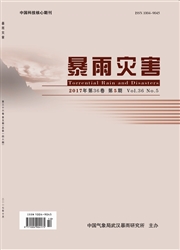

 中文摘要:
中文摘要:
利用中尺度大气模式AREM与国际上比较成熟的海浪模式WAVEWATCH-III进行双向耦合,应用管道通信技术建立区域中尺度大气-海浪耦合模式预报系统,充分考虑中尺度海-气间的相互作用,即大气低层风场驱动海浪并影响海浪状态变化,海浪通过与波龄密切相关的海表粗糙度和海洋飞沫来改变海气间动量、感热和潜热交换从而实现对大气的反馈。文中利用该耦合预报系统对发生在东南沿海的“威马逊”台风过程进行数值试验,重点分析海表粗糙度和海洋飞沫两个耦合因子对台风数值预报的影响。主要结论是:在台风高海况下,海浪引起的海表粗糙度和海洋飞沫的增加对台风数值预报影响均较为显著。海表粗糙度加大了海气间动量通量(摩擦作用),其阻碍台风的发展,但对台风路径预报影响不大;海洋飞沫贡献的感热和潜热为台风发展提供能量,从而使台风强度增强,降水显著增加,并使台风路径预报更加接近实况;两者共同的作用,使台风强度增强,台风路径预报也更为合理。
 英文摘要:
英文摘要:
Based on the mesoscale atmospheric model AREM and the popular wave model WAVEWATCH- Ⅲ, a two-way regional mesoscale atmosphere-ocean wave coupling model has been built with pipe communication technology considered the air-sea interaction fully. The near-surface wind directly drove the state of ocean wave; on the other hand, the ocean wave energy fed back to air by changing the momentum,sensible heat and latent heat between air and sea through the spray and the roughness related with the wave age. The coupled system has successfully forecasted No. 0205 typhoon Rammasun. It has been found that under high wind conditions, both the roughness and spray had a large effect on the typhoon system. Sea spray increased the intensity and precipitation of typhoon through enhancing the latent heat flux and sensible heat flux, while the roughness enhances air-sea momentum exchange (friction)to decrease the intensity and precipitation of typhoon. Moreover, the typhoon track was sensitive to sea spray but little to roughness.
 同期刊论文项目
同期刊论文项目
 同项目期刊论文
同项目期刊论文
 A new analytical model for thermal stresses in multi-phase materials and lifetime prediction methods
A new analytical model for thermal stresses in multi-phase materials and lifetime prediction methods 期刊信息
期刊信息
